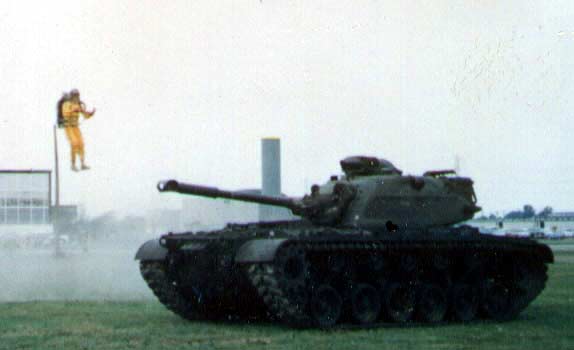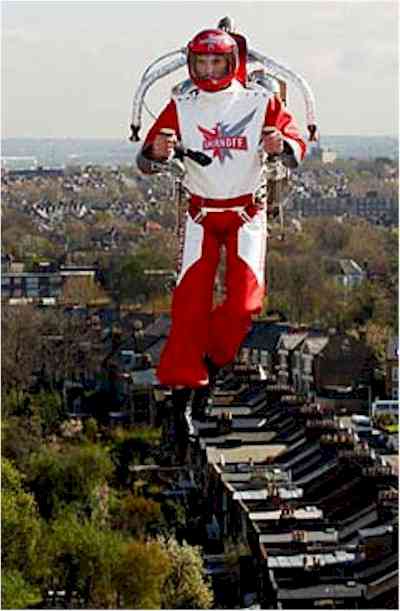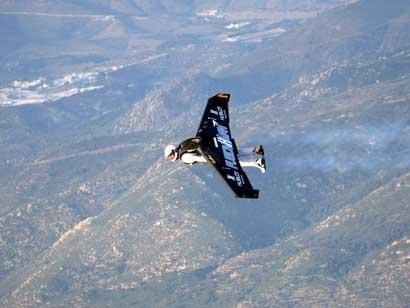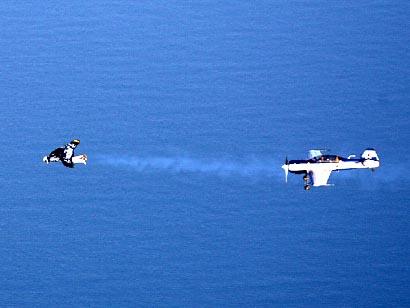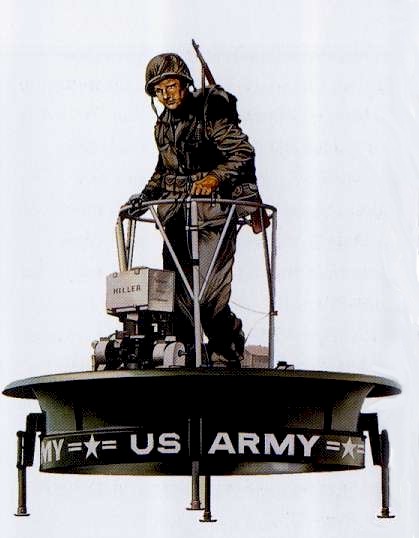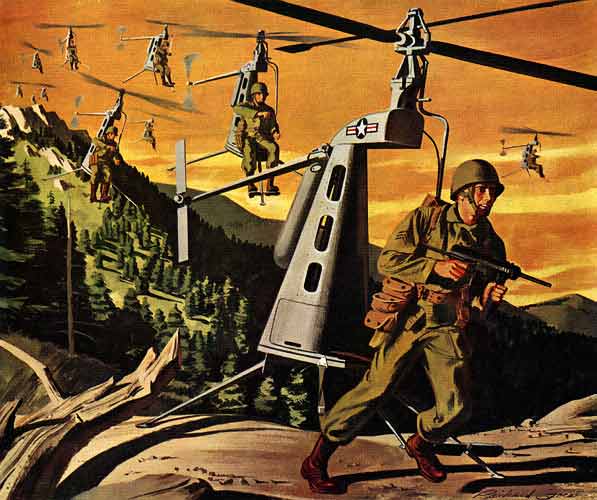Imperfect Ideas
Bell Aerosystems Jet BeltInsisting on perfect safety is for people who don't have the balls to live in the real world. - Mary Shafer, NASA Ames Dryden
Bell's highly successful and unique Rocket and Jet Belts resulted from an original idea said to have been first drawn out in the desert sand near Edwards Air Force Base by Bell Aerosystems' engineer Wendell Moore, in 1953. The initial Small Rocket Lift Device (SRLD) or Rocket Belt was a minimum strap-on back-pack system intended to lift a man in controlled flight over a short distance. For early trials, an experimental unit was devised using nitrogen gas and two downward-facing nozzles, initially tested on a rig to evaluate stability and other technical issues. It quickly became clear that the nozzles were too close to the pilot, as one operator lost his jacket sleeves in the blast. US Army interest was inevitable and in 1960 Bell received a contract from the Transportation, Research and Engineering Command to develop the SRLD into a working system. For this, Aerojet-General developed a 280-pound (127-kg) variable thrust rocket motor. Thrust control was effected by the pilot's right-hand squeeze throttle, while jetavator gas deflectors provided yaw control via the pilot's left-hand controls. Following a large number of tethered trials, on 20 April 1961 Harold Graham made the first-ever free flight with the SRLD, lasting 13 seconds and flying slowly forward at minimal height. As the operating envelop was extended, soon the SRLD was demonstrating flights of 860 feet (262 m) in length, altitudes of 60 feet (18 m) and speeds of almost 60 miles per hour (96 km/h), ideal for infantry to cross minefields, rivers, defences and other obstacles or for amphibious landings. Hundreds of flights were made with the SRLD, including a special demonstration to President Kennedy in October 1961, when a pilot lifted from an amphibious craft and flew over water before landing directly in front of the President.
Hal Graham enjoying his moment of fame One shortcoming of the Rocket Belt was the limited duration of the rocket motor. Such was the potential of the system, however, that the U S Army contracted Bell to develop a Jet Belt, which used a Williams Research Corporation WR-19 turbojet engine in place of the rocket motor. With this, an endurance of up to 26 minutes was anticipated. First flown on 7 April 1969, many successful flights were made, but neither this nor the Rocket system went into production.
Free as a bird... Source: The World's Strangest Aircraft: A Collection of Weird and Wonderful Flying Machines by Michael Taylor See also:
-------- Original Message -------- This message was posted via the Feedback form. Comments: Love the animated video of the Rocketbelt. The footage that you received from Hal Graham was taken by my father, Tom Lennon, Senior Photographer and ONLY Cinematographer at Bell from 1950-1978. If you can give him credit it would be greatly appreciated. Also - I am working with Rocketbelt Guru Peter Gijsberts and we having a rocketbelt convention on September 23 - 24, 2006 at the Niagara Aerospace Museum in Niagara Falls NY. Check out Peter's website if you are interested. All living original pilots are coming and we will also have a flight by GoFast! Rocketman Eric Scott. Kathleen Lennon Clough
"Rocketman" Takes Wing
Stuntman Eric Scott of the US hovering in the sky over London using a jetpack Rocketman Eric Scott shot 46 metres into the air in London and promptly claimed a world record. Scott, 41, from Dallas, Texas, donned his red and white jumpsuit and zoomed into the north London sky in his bid to achieve the highest human elevation using a Rocketbelt. His feat, which saw him reach the equivalent height of a 12-storey building, lasted just 26 seconds but allowed enough time for a couple of pirouettes. The father of three said after his flight, launched outside the Castle Indoor Climbing Centre in Stoke Newington: "There were no records before. I am the first one in the books for the record so it is neat. The feeling is so hard to describe, but it is like a dream that's reality. It went well. I went up there and when I got to the top I did a little pirouette, a 360 degree spin, so that was fun. I did another one and went to the landing area. Put my toes to the ground and took it off. It's just the most crucial part - it doesn't matter how good you flight, you have to land it!" Scott, who says his sons think he is Superman, works as a film stuntman and also builds custom homes. He was offered the chance to become a rocket pilot on a Michael Jackson tour in 1992. Since then he has become a veteran of almost 500 flights and claims to be the world's only Rocketman. His next public outing will be in the Brazilian jungle in July. The Rocketbelt was devised by the United States military in 1961 but has since been used for performances and displays around the world, including the 1984 Olympic Games in Los Angeles. The super-powered generator is mounted on a fibreglass corset that is strapped to the pilot. Two rocket nozzles fire super-heated hydrogen peroxide steam to propel the pilot into flight. The belt is then manœuvred with basic controls, including a throttle. - PA Source: www.smh.com.au 21 April 2004
Rocketman Takes to the Skies
A Swiss pilot has turned himself into a "rocketman" by strapping a pair of wings and two jet engines to his back. Yves Rossy, 45, a former airforce fighter pilot, gave his carbon wings their first test flight in Spain. He said: "It is absolutely fantastic. Total freedom in 3 dimensions, so much speed and power, it was better than being a bird. I have to jump from a moving plane as I can't really take off from an airfield like a real plane, I couldn't run that fast", he said laughing, and added: "I don't have an undercarriage either." To land he has to cut the engines and coast to the ground, using a conventional parachute at the last minute. Mr Rossy spent 5 years developing his 3-metre carbon fibre wings for his flying man project, then added 2 kerosene-powered jet engines to his original wing design. Handles are fixed onto the wings so that Yves can electronically manipulate the wingtips, giving him the freedom to decide when he wanted to either glide or dive. He said: "After I jumped my wings opened like a bird taking wing; I then glided down to 2,500 metres, and ignited the kerosene engines. There was a short period, 30 seconds, while I waited for them to stabilize and then I began to open the throttle. I soon realised I was no longer losing height, and achieved horizontal flight for more than 4 minutes at 100 knots (115mph)." Source: www.ananova.com 23 March 2007 photo credit Europics
Hiller VZ-1 Do-NutIt is difficult to say what is impossible, for the dream of yesterday is the hope of today and the reality of tomorrow. - Robert Goddard
Artist's drawing of a Hiller VZ-1 Do-Nut one-man infantry VTOL flying platform of 1959, of which two were built for experimental trials with the US Army. It used a ducted propeller to provide thrust. After 1969, Bell and Williams went on to develop two-person flying platforms that were so stable the crew only had to lean in the direction they wanted to fly, thereby requiring just thrust control. Among expected applications was astronaut mobility on the moon. Source: The World's Strangest Aircraft: A Collection of Weird and Wonderful Flying Machines by Michael Taylor
Inventions that Fell to EarthHiller Flying PlatformWhen it worked properly, this was a disc on which a man could stand and fly. Hiller Aviation of Palo Alto in California developed it in the fifties with the US military. It was to be used to spot artillery or move troops. Below the platform a rotor generated the thrust. Landings were rough and only seven platforms were made. The project is long scrapped. Rocket BeltBuilt in 1960 by Wendell Moore, it looked like the James Bond jet pack. Its hydrogen peroxide power generated bursts of steam that thrust it into the air. On one test, a man travelled 40 metres, three metres less than the Wright Brothers in 1903. Sadly, the fuel lasted only 21.5 seconds. Sinclair C5Inventor Sir Clive Sinclair unveiled the C5 in January, 1985. Three-wheeled, battery-powered, with a washing-machine motor, the C5 was an object of ridicule. Nobody would brave traffic in it and the battery lasted only a few miles. Sir Clive's dreams of selling hundreds of thousands vanished; Sinclair Vehicles was wound up 10 months after the launch. Source: news.independent.co.uk 30 January 2003
Strap-On Flying Machine Goes Up for AuctionA strap-on flying machine is going up for auction, but the buyer must agree never to fly it. Bidding for the SoloTrek XFV is expected reach more than £600,000 on auction website eBay. The prototype, which made its maiden flight a year ago, is designed by California-based Trek Aerospace. To protect the company from legal action, the successful bidder must sign a contract promising not to fly it. It is built to fly somebody weighing up to 13 stone (182 pounds) at nearly 70mph for 100 miles. Two overhead fans lift the gas-powered machine and it's steered with a joystick in each hand. Michael Moshier, chief executive of Trek Aerospace, says it has only hovered a few feet off the ground in tests. He said, "We didn't want to test it higher than we were willing to fall." Mr Moshier expects to sell the aluminium and titanium machine to a museum or aviation enthusiast. The company retired the prototype last summer to concentrate on a second-generation model with better joysticks and a smoother engine. It hopes to sell personal flying machines to the military, allowing soldiers to pass over swamps, mine fields and other rough terrain. Source: www.ananova.com Friday 10 January 2003
Also see Andreas Petzoldt's Personal Flying Suit Project for details and photographs of another "rocket belt".
Solar Copter?
World's smallest gas turbines to lift a sky full of men Source: ephemeranow.com
To view other articles related to flying including history, unusual flying machines, hot air balloons, skydiving, gliding, problems, airports, turbulence, pilots, crashes,
the Paris Air Show, the future, blimps, space travel, solar sails and more, clicking the "Up" button below will take you to the Table of Contents for this section on Flight. |
 Animals
Animals Animation
Animation Art of Playing Cards
Art of Playing Cards Drugs
Drugs Education
Education Environment
Environment Flying
Flying History
History Humour
Humour Immigration
Immigration Info/Tech
Info/Tech Intellectual/Entertaining
Intellectual/Entertaining Lifestyles
Lifestyles Men
Men Money/Politics/Law
Money/Politics/Law New Jersey
New Jersey Odds and Oddities
Odds and Oddities Older & Under
Older & Under Photography
Photography Prisons
Prisons Relationships
Relationships Science
Science Social/Cultural
Social/Cultural Terrorism
Terrorism Wellington
Wellington Working
Working Zero Return Investment
Zero Return Investment

